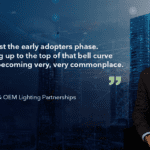
From the Top of the Bell Curve: Navigating Today’s IoT Landscape
This article in Electrical Contractor highlights the widespread adoption of IoT technology across various sectors, featuring insights from Enlighted's Rob Groff, who emphasizes IoT's move into mainstream.
The Internet of Things (IoT) is now firmly entrenched in mainstream applications spanning homes, offices, manufacturing lines, and even agricultural fields, highlights a recent article in Electrical Contractor by Jeff Gavin, featuring Enlighted’s Rob Groff, manager of solutions consulting, IoT channel sales, on the scaling and proliferation of IoT.
“We’re well past the early adopters phase,” says Groff. “We’re heading up to the top of that bell curve where IoT is becoming very, very commonplace.”
Enlighted offers scalable lighting controls and IoT technology for workplaces like offices, manufacturing, education, biotech and pharma, and data centers. Groff emphasizes that the journey towards embracing IoT has challenges, particularly in understanding how best to invest and apply it effectively.
The ROI of IoT
Groff advises that understanding the return on investment (ROI) of IoT projects is critical. Unlike traditional equipment purchases, IoT initiatives entail a longer, more iterative process. It’s not just about installing smart devices; it’s about leveraging their data intelligently to make informed space decisions, increase operational efficiency, and save energy. Groff highlights the importance of understanding the total cost of ownership, advising that when contractors grasp the intricacies of IoT systems, the cost becomes comparable to conventional setups.
The New Bidding Process
The rise of IoT has changed the bidding process for electrical projects. It’s no longer about simply installing fixtures and switches. Today’s electrical contractors need to understand how to integrate sensors and other devices into their systems, often requiring new technical knowledge and expertise.
“A lot of times electrical contractors aren’t being educated as to the ‘why’ [of the IoT project], why are they installing this,” Groff said. “If they know the ‘why,’ then they can look at the obstacles during installation, understand what parts of the building or installation are going to interfere with the goals of the system.”
For example, one of the biggest challenges is understanding how to accurately quote a project that includes IoT components that interact with each other–the lighting fixtures and the technology within those fixtures. The number of sensors required can significantly impact the cost of a project, paired with potential obstacles that interfere with wireless communication, such as walls or metal structures.
In summary, as workplaces continue to embrace digitization and IoT integration, proactive planning, collaborative efforts across teams and functions, and a deep understanding of IoT systems are essential to navigate and harness the full potential of this dynamic landscape.
A key factor in IoT implementation is the integration of wired and wireless technologies. While wireless connectivity is integral to IoT systems, Groff points out that most installations blend wired and wireless components. Integrating sensors and control units into light fixtures streamlines the installation process, enabling efficient zoning and effective communication between devices. This integration extends beyond lighting control and includes occupancy monitoring, ambient light sensing, and temperature regulation.
By collecting real-time data at a granular level across all, Groff shares, Enlighted empowers users to make data-driven decisions that drive outcomes like building energy savings, efficiency, and productivity, creating a more comfortable work environment for occupants–and optimizing building systems management.
The brightest way to operate, orchestrate, and optimize everyday spaces.


